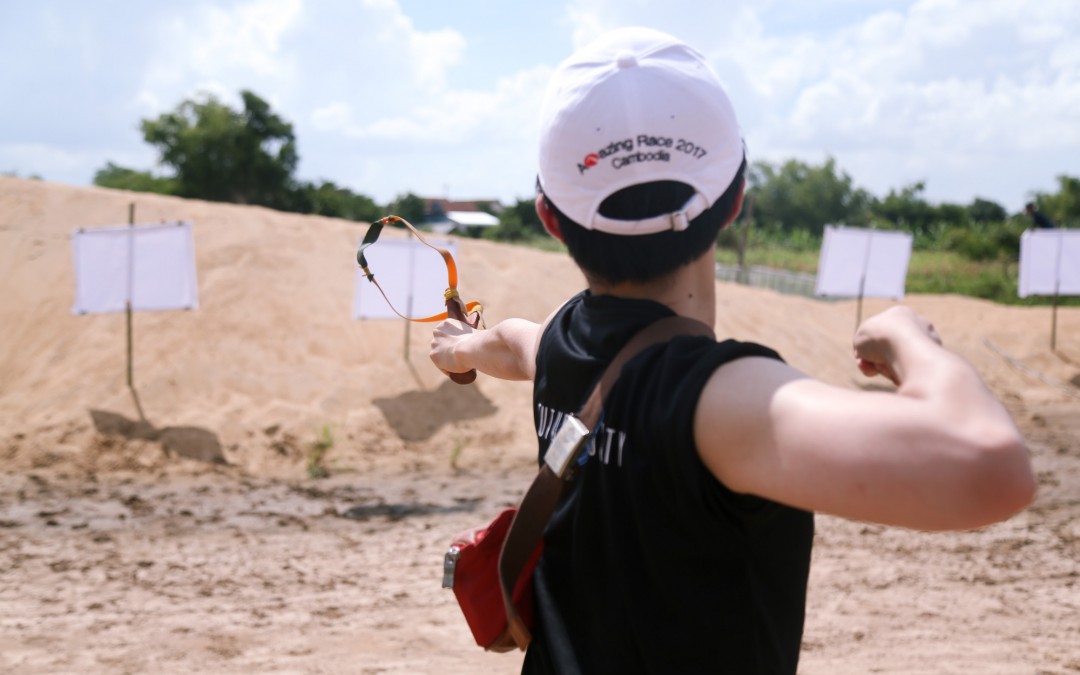
by Nick | Nov 16, 2017 | Bike, Blog, MICE
The Mobileiron Mekong Challenge
The Setting
The Mekong, its islands, public ferries and the East Bank, the antidote to a frenetic Phnom Penh on the other side of the river.
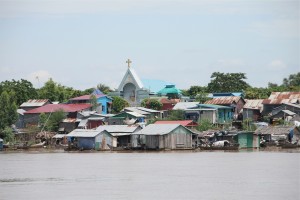 Areykhsat on the East Bank of The Mekong
Areykhsat on the East Bank of The Mekong
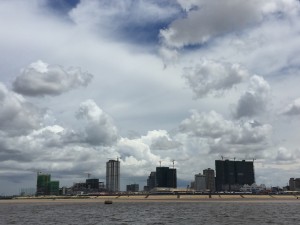 Phnom Penh on the West bank of The Mekong
Phnom Penh on the West bank of The Mekong
The Challenge
Khmer games; Climbing sugar palm trees to pluck sugar palm fruit, or strategically placed little bottles of sugar palm wine in grass baskets. Shooting slingshots, a blindfold bash of clay pots with more containers this time filled with Mekong Whisky. A tug of War in a cow field, volleyball heats at a pagoda, a muddy mountain bike ride and a Buddhist water blessing (they had to find the monks first).
The Teams
Initially sixty, worn down by the ravages of the conference dinner leaving 35 survivors grouped in teams of 5 tech execs working for a multi national data protection company.
The Build Up
Buntha and I got off the ferry at Areykhsat and looked at each other, ‘what are we going to do next?’ Find a pagoda. ‘Can you bless some Americans?’ We asked a monk, then cycled along the road in search of a silk farm, a main road with the usual crazy Khmer traffic? ‘This wont do, ‘Buntha come back tomorrow and find an off-road route.’
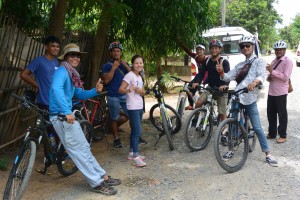 Setting up the games with our Team the day before
Setting up the games with our Team the day before
The Day
First problem; there were too many bikes (60) and not enough space at the Prek Leap Ferry. Buntha called, ‘flying bikes have set them up at the pagoda,’ which pagoda I wondered? Which lead onto the third problem.
Second problem; bladders, probably abused over the conference week, they weren’t holding what they should in the midday Cambodian heat. Everyone wanted a piss. The men were easy, ‘go in the bushes,’ I waved in a wide sweep towards the pagoda’s bush-bereft horizon. The lady was more difficult but she disappeared with Ra and came back happy.
Third problem; ‘Follow me,’ I confidently cried, over my shoulder and headed off down a bumpy road in the wrong direction. The phone rang, it was Buntha, ‘Nick you’ve gone the wrong way.’ ‘False start guys,’ I shouted and turned round which left the Vice President and boss at the back and the slowest at the front. A little ruse I mused.
Like an unleashed tribe of braves on the warpath, they bore down on me and the ferry. The first casualty skidded up the ramp onto the deck having parted company with his bicycle but no obvious damage done.
 Mobileiron Braves on the warpath
Mobileiron Braves on the warpath
The boat had left the dock as a well-proportioned member cycled to the waterfront. ‘Too late’ I shouted fearing that the employee might try a death- defying leap across the Mekong. I was drowned out, his colleagues roared and the ferry returned.
Lors had done us proud placing the Mobileiron direction indicators at each turning except they were upsi down and read Wobileiron. Also in his zeal to help the teams he’d written the distance to the next challenge in kilograms, confusing his metrics and indicating that the Wobileirons would be 2kg lighter by the time they reached the Tug of War.
The Sugar Palm Challenge
Buntha had gone to incredible lengths to construct ladders akin to the bamboo poles that run up the side of the sugar palm trees.
They were metal tubes with welded lengths of steel for rungs, enough for a gravitationally challenged tech executive we thought except they started pinging like bursting pods and left our Wobileirons clinging on for dear life.
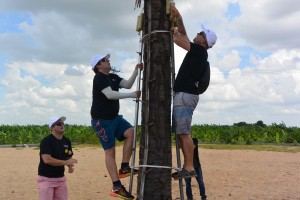 Wobileirons climbing the sugar palm pole
Wobileirons climbing the sugar palm pole
The Slingshot Trials
The incentive of winning and alcohol meant this didn’t deter them for long and soon they were off to shoot things. They loved it so the slingshots were a success with the Anglo Saxons. The Japanese kept hitting their hands and sending the pellets backwards.
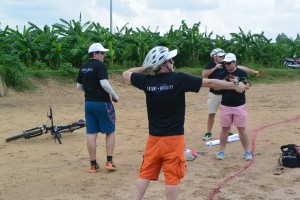
On second thoughts perhaps a missed opportunity as we could have combined the palm tree challenge, slingshot trials and water blessing by shooting monks out of palm trees.
The ferry man had us by the balls and the more the Anglo Saxons screamed to leave and keep their lead the more he grinned and asked for another dollar.
I pointed out that they would need a competing team for the tug of war and volleyball so we waited for the Grey Team.
The Breaking Pot Bash
Across the river we’d tied clay pots to a Boddhi tree ready for the breaking pot bash.
The idea was for us to leap frog in front of the Wobileirons but the Anglo Saxons and the head office team were going too fast.
Sreymom was left trying to tie blindfolds on burly Singaporeans two times her height, spin them round then run for dear life as they started blindly bashing their bamboo staffs to hit the pots and reap the rasping reward of the Mekong Whisky inside.
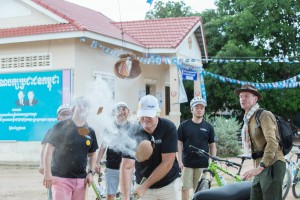
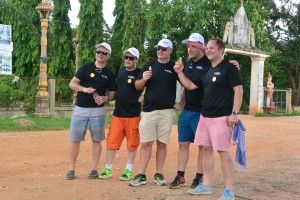 The Anglo Saxons reaching the foregone conclusion that they’d won
The Anglo Saxons reaching the foregone conclusion that they’d won
Tug of War
We sent Lors, our adventure guide racing ahead to the Tug of War field. He found his métier as the macho muscle man and appealed to the Anglo Saxons.
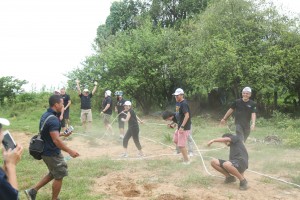
 Spectators @ The Tug of War (below)
Spectators @ The Tug of War (below)
The Japanese Team kept loosing so they asked the Anglo Saxons if they could have one more tug but this time with Lors. This time they pulled the Anglo Saxons off their feet then fell backwards as the rope came loose.
The Volleyball Heats
Wat Svey Chrum was just across the road. There was a Wobileiron sign but the VP and his financial director headed off towards Vietnam unnoticed until another of the Anglo Saxons suggested it might be PC to find him. We duly found them a few kilometers down the road and directed them back to the pagoda.
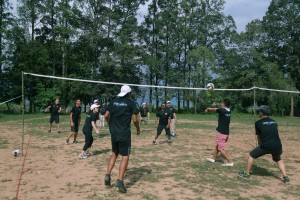
Buntha’s rules as interpreted by Jin appeared arbitrary but with only 3 pax on each team our brave contestants did their best. The VP fell in a leaping lung while another team member nearly killed a bystander so Jin speeded up the scoring to get one of the teams past 5 points.
Muddy Mountain Bike Ride
Buntha and I had carefully researched a particular route but the teams seemed to find quite a few, which they chose at random throughout the afternoon. I took advantage of my proximity to the Anglo Saxons to lead them along the prescribed path to Wat Areykhsat where they had to find a monk and receive their blessings.
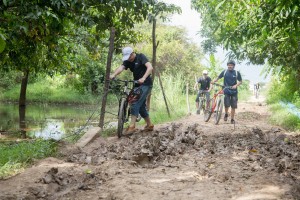
Water Blessing
The monks mindful of the promised payments per contestant found our teams then made them follow the ceremony with the appropriate and traditional respect. The contestants duly knelt and touched the ground with their heads then hands together bowed three times to the monks who represented Buddha.
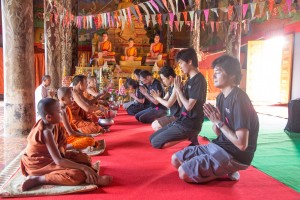
The Anglo Saxons were still up for it though their team was dispersed across Kandal and possibly Takeo Province by this stage. They were on the first ferry across The Mekong then raced beside the river through Phnom Penh to the FCC unsurprisingly winning the race.
I leant on the railings above the ferry station with a blissful beer. Lors had just lead what we hoped were the last teams to the FCC. Buntha hung on the other side of The Mekong to look for lost Wobileirons in case they hadn’t made it.

The all clear came through, 35 counted out and 35 counted back.
Postscript
We were lucky that the weather was kind and it helped that we chasing after 35 not 60.
Bunthy had chosen a restaurant half way between Phnom Penh and Battambang for dinner, which stopped being amusing after 50 minutes in the tuktuk trying to find it.
Once a beer had been placed in my hand and the manager dispatched to find wine I realized with a rising tide of pride what a fantastic team we are.
Oh and Jin sang a song and established that Lors would not interfere with him.
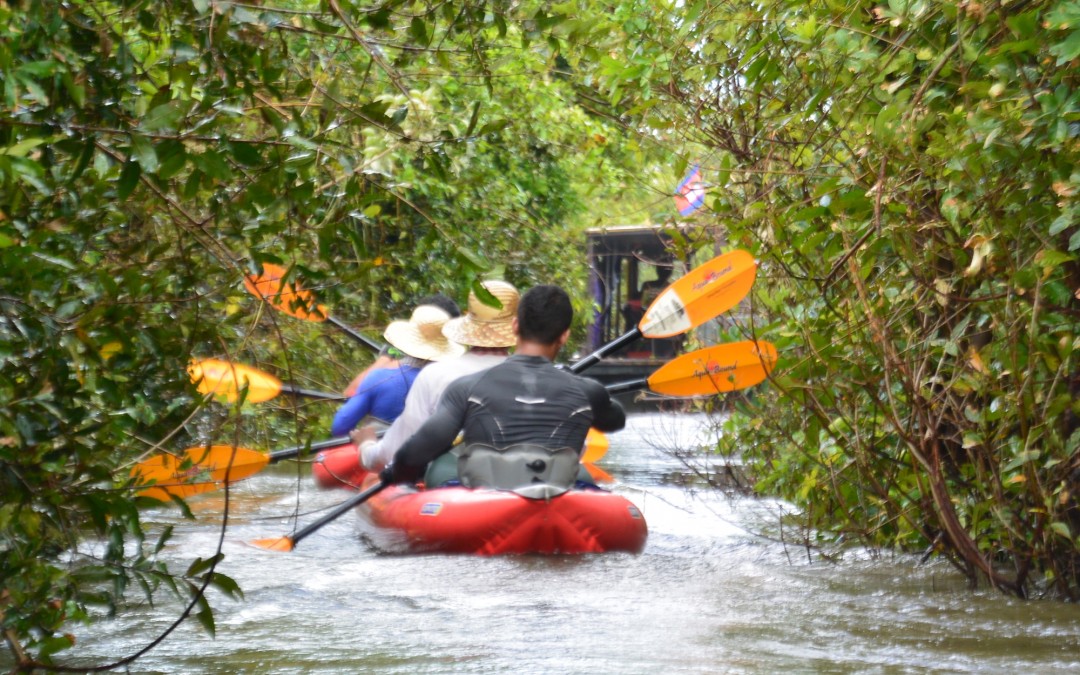
by Nick | Oct 26, 2017 | Blog, Kayak, Uncategorized
The Sangke River Kayak
This is the story of 5 men and their boats as they paddled across the floodplain of The Tonle Sap Great Lake from Battambang to Angkor.
We couldn’t let our muscles go to waste so despite we’d 3 days ahead of us and an unknown quantity of kilometers, the first objective on reaching Battambang was to firm up the engines that were going to drive us and find a gym.
Motors tuned in anticipation they now had to be fueled and this was where we split. The allure of Jaan Bai* was too strong and too expensive for the whole Team. ‘I’ll see you in the morning,’ I told them.
The next morning the call of coffee transcended our budget so we all congregated at Knyei** for a cup of arguably the best coffee in Asia before setting out on our voyage.
Prasat Prahoc*** lives up to its name, smelly – but it gave us a 10K head start.
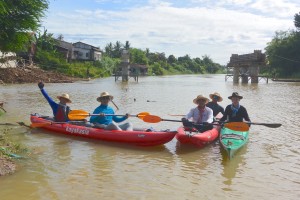 Setting off at Prasat Prahoc, from left to right; Buntha, Ra, Jin, Lors and Nick
Setting off at Prasat Prahoc, from left to right; Buntha, Ra, Jin, Lors and Nick
I had an unfair advantage but that seemed reasonable in light of a 30year disadvantage. The green hard hulled composite kayak cut though the water faster than our Gumotex war horses but given they had 2 prime paddlers per boat we were about matched.
* Jaan Bai; initially a David Thompson cooking school restaurant now run by Mark & Jose from Feelgood Coffee, also owners of **Knyei Café. Originally an NGO running cycling trips it now concentrates on amazing coffee in street 1 ½. *** Prahoc a Cambodian staple, fermented fish paste – an acquired taste.
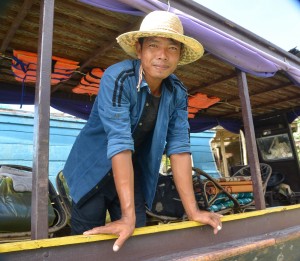
Heang (above) concerned, intelligent, efficient was waiting with his motorboat. Don’t get me wrong, we were going to kayak but we might as well do it comfortably, which meant keeping the beer cold.
The sun was shining (about 40 degrees and humid, a minor point). The river high and most important the current was heading our way.
To set the scene we were traveling downstream with the Sangke as it flowed from the Cardamom Mountains to the West, past Battambang and onto Prek Toal and the Tonle Sap Lake. Our mission was to follow its length albeit with a shortcut at the end to the floating village of Maichrey, our final destination.
 The Upper Sangke flowing through rural Battambong Province
The Upper Sangke flowing through rural Battambong Province
‘2 hours then adventure bars*’ I shouted. All was well excepting Jin who was car-sick the day before and quieter than usual. And water, whatever we drank sweated straight out, perhaps 5 liters that first day.
*Adventure Bars; a special recipe created by Dean from Miss Wong, granola bars in global demand but only available on Indochine Exploration Adventures.
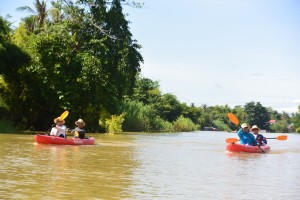
Buntha’s app told us we were averaging 7K such that after a couple of hours the river rose to meet the banks. The bamboo clumps and fruit trees thinned as we entered the middle Sangke, a region of endless rice fields.
I knew the route from the perspective of the Amanbala or whatever the motorboat I was traveling on at the time but from the kayak, under our own steam my relationship with the river was different and more connected.
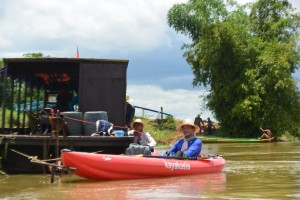 Adventure bars and coffee as we entered the middle Sangke, where stilted houses give way to floating villages.
Adventure bars and coffee as we entered the middle Sangke, where stilted houses give way to floating villages.
The current was cancelled by the rising lake, fast breaching the riverbanks and flooding the surrounding paddy fields. It felt like we were rising above the world to where the water met the sky.
On the patches that stood proud the trees were festooned with the strange fruit of weaver nests. Structures of woven grass attached to branches, which the birds entered like a diving bell from below. They sell these nests in Siem Reap, hanging them to their awnings thinking that the tourists will like the rustic impression they give but not caring for the birds that weaved them. It was cheerful to see them undisturbed next to the fishermen‘s huts.
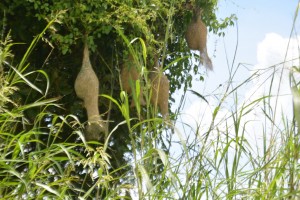 Weaver Bird nests
Weaver Bird nests
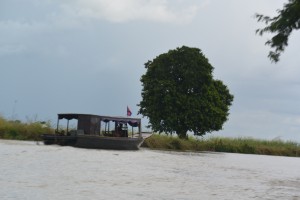 Into the Tonle Sap Floodplain
Into the Tonle Sap Floodplain
It’s true that an army marches on its stomach and now past 12 there was mutiny in the air, rice was need quickly. We found a perfect spot and tied up to the remnants of an old wooden house now mainly underwater and home to a family of rats. A snake swam across the river to join us for lunch.
Clouds ominous, the boys had the rice on the boil as the heavens opened and the rain poured down while Lors entertained us with his sexual encounters, apparently he doesn’t like sucking nipples. Other valuable advice was to follow the beaten path so you don’t have to cut the bush? Oh and we also learnt that he weighs 72kg before a shit and 70kg after.
 The encroaching lake
The encroaching lake
The rains have been good this year and the water was high so still with 2 months of flood to come we were able to cut off a 20K meander with a 5K cut through the seasonally flooded forest. An enchanted alley glistening from the recent rain, sunbeams splashing on shiny wet leaves.
I was thinking about Silver Langurs. Our hike through the Kulen Hills to the North of Siem Reap was set up to give the local villagers an incentive to protect the monkeys. But for all the talk honestly I wasn’t sure if I’d ever seen them. On queue, perched on a branch just 5 meters away was a Silver Langur and a few strokes further more brought me close enough to confirm.
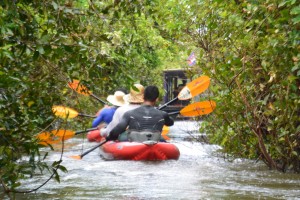 The shortcut, an enchanted alley cut through the seasonally flooded forest
The shortcut, an enchanted alley cut through the seasonally flooded forest
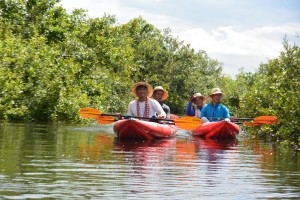
The birdsong beckoned but we weren’t the only ones taking advantage of the narrow channel. Most boats slowed as they came near, a few young idiots threw a wake over our Gumotex coming to an abrupt halt when they met Heang and his motorboat.
Phum Bakprea, the halfway point where the Sangke meets the Monkul Borey River. A water hyacinth jam, we could see the telephone masts of the village but 10m of compacted weed meant it could have been the moon. Of course Lors the machine that he is could heave his way through but the rest of us waited for Heang to tow us.
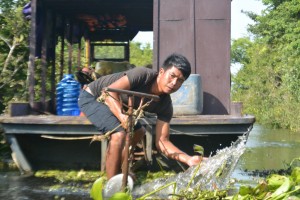 Heang towing us out of a hyacinth jam
Heang towing us out of a hyacinth jam
Heang threw a line to me and Buntha attached his rope to my tail, slowly we squeezed through the floating mat. The broad blades of his propellers were alarmingly close but after our recent battles see a water hyacinth workout, they were preferable to be being stuck.
Google Earth shows a road reaching the village in the dry season but for now its isolated in the The Tonle Sap floodplain. A river rendezvous where the tourist boats refuel on route to Siem Reap. A big sign advertised a Battambang boutique guesthouse complete with swimming pool somewhat at odds with the largest pool in South East Asia, where we were currently floating.
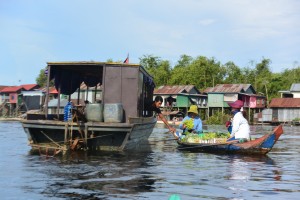 Phum Bakprea, picking up bananas
Phum Bakprea, picking up bananas
It was half past four, we’d been going since eight and were getting tired, a coconut stop. ‘Wat Chou Kmao 40 minutes,’ Heang told us. We could sleep with the monks at the pagoda.
Chased by rolling waves of angry grey clouds getting darker and darker pushing a wall of wind behind us we surfed down the river, flying in the face of the storm.
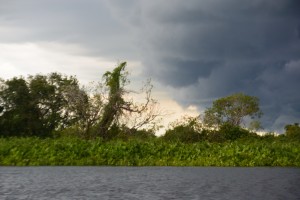 Chased by a storm down the river
Chased by a storm down the river
As the storm surge subsided we approached a village looking for a place to rest. Despite the statuesque youth in underpants, the thump of amplified base persuaded us to keep paddling. A little further on was an empty platform but for some nimbi- ish reason it was off limits so we wearily continued in the twilight.
A pale flicker of light bathed the river as we put forward our paddles after 10 hours and floated towards our mother-ship, where we were going to sleep that night.
The clear water was alive with fish minus one as Lors caught a half kilo catfish on a thin bamboo pole, which together with a bucket of snails that kept escaping was lunch for tomorrow. Compelled by hunger the team had rice pots boiling and were dicing and cutting vegetables and meat. Caught in a limbo of disconnected and contented exhaustion I looked on with a cold beer while they cooked supper and contemplated my paddling companions. Ra an old woman but eternally nice, Buntha smart as always, Jin the baby but never complaining, so full of goodness he should be on the front of a breakfast cereal packet and indestructible Lors. I felt extremely fortunate.
The boys were content to lie on mats. I had a mattress. Under mosquito nets we lay across the width of the boat. The heavy and humid air was contained by blinds hanging on either side with the aim of stopping us getting wet. The rain started just as we were dozing off.
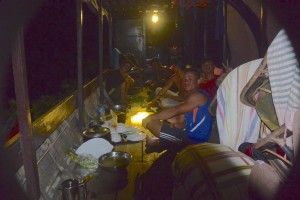 Lors and the boys cooking dinner.
Lors and the boys cooking dinner.
Attempting to sleep the volume increased and it started to seep through the covers slowly filling the boat lapping at my mattress by now more of a sponge. Heang turned on the bilge every hour ensuring that only glimpses of sleep were snatched. I must have drifted off as a pale dawn penetrated my Valium induced torpor.
Lors was the first thing I heard. ‘How many nights do you need to get by without sleep before you get tired?’ ‘What?’ ‘He means shut up,’ Buntha interpreted and handed me a hot mug of tea. Heang lifted the covers revealing the grey green river-scape and the next day seemed possible.
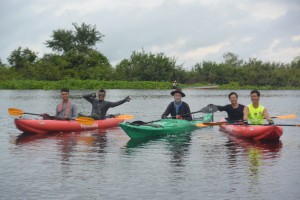 Setting off a little less enthusiastically on our second morning
Setting off a little less enthusiastically on our second morning
‘How far now Heang,’ we asked. ‘I think you do 55%,’ he replied rather too diplomatically. The prospect of another sodden night was enough for us to decide to try and make it back in one day.
The current had gone, the river was wide and meandering away from the prevailing Westerly wind that had propelled us the night before so we paddled by ourselves.
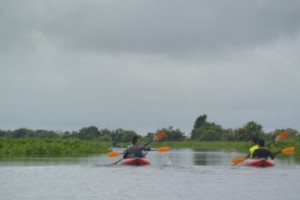 Heavy hanging grey clouds at least meant we weren’t being grilled by the sun.
Heavy hanging grey clouds at least meant we weren’t being grilled by the sun.
It was a good call to have stopped where we did, Wat Chou Kmau was another hour from where we had moored for the night.
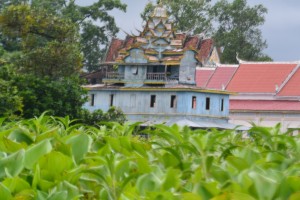
Heang was waiting after another 5km beside a pagoda in the center of a large stilted village.
The river was completely blocked by hyacinth so when we saw a seller boat heading off into the flooded forest on one side of the channel we reckoned they knew a way through. We followed and came out the other side, which was more than Heang managed and for some unfathomable reason he’d headed back towards Phum Bakprea. ‘Why don’t they clear it?’ I thought. Collective action for the benefit of all but it’s less effort to get a long tail with a reverberating 2 stroke and cut through alone – I answered myself.
Grey water under a grey sky, open stretches of river in shoulder aching straight lines between floating villages now the flood lasted longer than the ebb. Seasonally flooded forest fringed the river. A Black-shouldered Kite flew near an untidy nest of random twigs watched over by a Grey-headed Fish Eagle. I just made out a monkey on the far bank but too far away to tell what flavor, parakeets, pelican, duck.
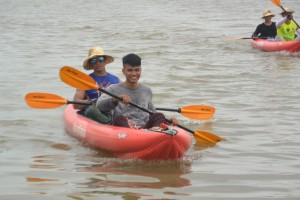 Lors and Jin towards the end
Lors and Jin towards the end
Another floating village where we waited for Heang who’d lost us in the water hyacinth, coffee and adventure bars, well done Dean.
Approaching our lunch stop at Kampong Prahoc we saw the 3 telephone masts of Prek Toal, visible from a long distance as it wasn’t K. Prahoc but another village 30 minutes the wrong side. Buntha had an excuse to go to Prek Toal, we didn’t but we ended up paddling there anyway. ‘Why didn’t we take the shortcut?’ I grumpily demanded. ‘Water hyacinth,’ mumbled Buntha. The excuse for everything, I thought but didn’t say.
The short cut to Maichrey an hours breeze with Jady a few weeks back but today a balance between general ache and the freedom of well just being free.
How many thousands, maybe millions of paddle strokes did we do? Shoulders aching, back in seizure, legs cramping, twenty hours in the kayaks and 80 kilometers paddled. I nearly cried when we got to the boat station at Maichrey.
‘So tired, ‘ Buntha said the first morning now a lifetime away, no stress, work and self irrelevant, just us Heang and the river.
 Lors, Heang, Nick, Ra and Jin at the end.
Lors, Heang, Nick, Ra and Jin at the end.
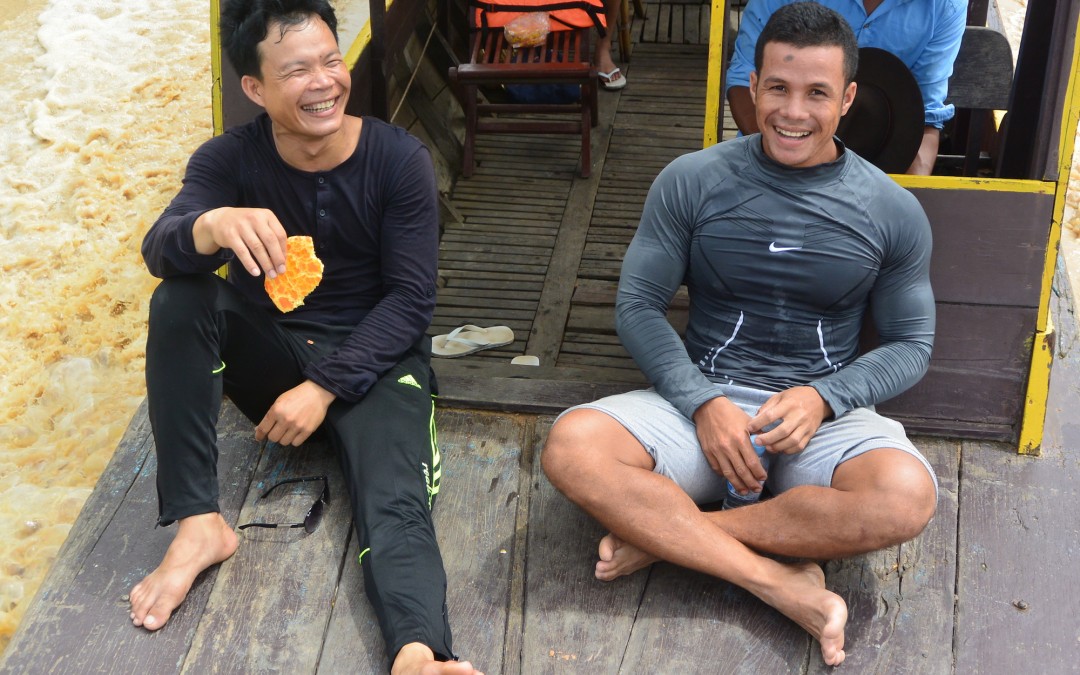
by Nick | Oct 25, 2017 | Kayak
A Water Hyacinth Workout
Heang was waiting at the Maichrey Boat Station with what looked liked the oldest wooden boat Bo the owner could find. The Team sprang into action, had the kayaks out the car, inflated and up on the roof of the relic that was taking us into The Tonle Sap Floodplain. I watched redundantly and remembered when it was only me that could set them up correctly.
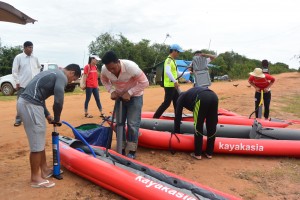 The Team setting up the kayaks (left), Buntha & Lors (below)
The Team setting up the kayaks (left), Buntha & Lors (below)
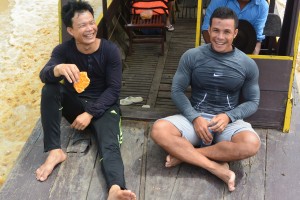
The lake is on the flood penetrating up the waterways that for half the year flow in the opposite direction and with the current comes the clumps of water hyacinth. A weed introduced from South America that floats on air sacs in its stem and was enemy No 1 for the day.
The same floating house that we saw yesterday on a customer trip was still stuck half way up the channel. Four young boys in a sad shack that didn’t look like it would make it through the next storm.
For once the mind numbing long tailed engines served a purpose cutting a path through the floating weed that unless you nose tailed perilously close to the churning propeller, fused back together after the long tail had made its way through.
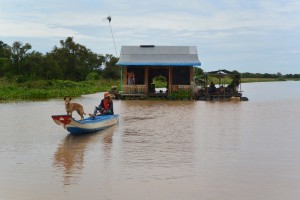 Moving house as The Lake fills
Moving house as The Lake fills
We launched our kayaks over the side of Heang’s boat and headed off into the unknown, flippantly and later regretfully I mentioned ‘to get lost.’ ‘Keep with us,’ my futile call went unheeded. Lors with his shirt off like some smooth gorilla together with Jin, who’s just so nice, paddled off. Bunthy and Ra, Buntha and Sreymom plus me solo, which with these fit guys puts me behind.
A little way past Maichrey we met our first water hyacinth barrage, easy as we followed the long tail through the chopped weed.
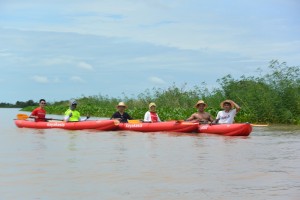 The Team in the open channel
The Team in the open channel
Like ginormous birds the A320’s circled overhead waiting to land at REP Airport as we struck up a rhythm in our kayaks along a wide channel. Smiles on our faces as we waded through the water. Note Gumotex inflatables reliably wade. The Feathercraft K1 whose tubes are being realigned in Singapore glides.
Confidently we waited at the second carpet of floating hyacinth for a long tail to cut us a path. I powered after and came to an abrupt halt after 50meters extricating myself backwards. No more boats appeared to cut a path for us. ‘Where’s Heang?’ I wondered. ‘Boss shall I try?’ Lors shouted over his back as he heaved their way through. We heard war cry’s as he attacked the floating mat with his immense strength ably aided by Jin. His shouts got fainter and their heads disappeared into a sea of leaves.
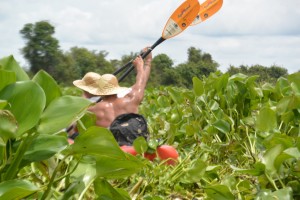 Lors and Jin heading into the hyacinth
Lors and Jin heading into the hyacinth
The rest of us looked at each other, sort of shrugged our shoulders with resignation and headed after them. I’d followed first but my shoulder muscles don’t compare so after 20 meters came to a grinding halt, wedging the kayak on the floating carpet. Ra and Bunthy squeezed past with Bunthy at the front clearing a way and Ra providing the power behind.
 Stuck!
Stuck!
‘Two questions Buntha, where are we going and how long to get there?’ ‘Prek Toal, by boat it’s close, by kayak through the hyacinth tomorrow.’ Hmm, actually he was wrong on both counts. An hour later we’d cut though to an oasis of clear water in the desert of hyacinth. ‘Nick just wait for Heang,’ said Buntha after he’d called him for the fourth time. Either Buntha or Heang and probably both of them don’t know where we are. The sound of fiberglass long tails could be heard tantalizingly close but not the chug of Heang’s heavy wooden boat.
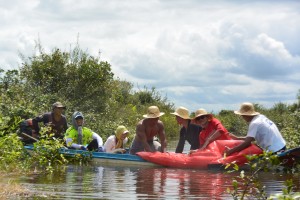 Hijacking the illegal fisherman’s long-tail
Hijacking the illegal fisherman’s long-tail
‘Heang’s not coming and we get the first long tail,’ I concluded. It turned out to only be another 20 meters where Lors and Jin waited on what appeared to be clear water.
The reverberating crash of the 2 stroked long tail engine grew and 2 kids appeared one clad in a fetching turquoise velvetine jacket and clashing orange wedding bonnet. ‘Its blocked,’ (in Khmer). The next driver didn’t have much choice as Lors turned pirate hijacked his boat. We transferred in pairs. Lors and Jin hauled the kayaks on board, deflated and rolled them up in the narrow boats. 7 of us sat on top of our rubber bundles while our driver headed off who knew and after the hyacinth, who cared where.
We’d come a long way, taller trees, clearer water and alleluia no hyacinth! Two Black-headed Ibis amongst Open-bills, a Grey-headed Fish Eagle disguised as a tree trunk, cormorants, darters and White-throated Kingfishers. We could have kayaked, I thought but an hour later we were still nosying our way through the flooded scrub with no sign of the Prek Toal telephone masts in sight. We came to a stop at an illegal fishing net blocking the narrow waterway. Our driver was an illegal fisherman but at that point we weren’t complaining. We gently untied the net and carried on. It had been a while, there were a lot of us in the boat and my thoughts turned to exactly how much fuel remained in the tank. And how long could our driver continue hacking through the undergrowth with a laboring engine before it gave up. The telephone masts appeared over the flooded scrub before my thoughts became reality.
The main channel in Prek Toal floating village presented the next challenge as the wake from other speeding long tails threatened to sink ours laden with us and our kayaks.
Heang was waiting for us at The Cheang platform (Buntha’s family), he and Poo our van driver had cooked lunch. We hadn’t been heading for Prek Toal but Kampong Prahoc 10km up the Sangke River and were nearly there before our illegal fisherman saved us. Chicken, cabbage and beer had never tasted so good.
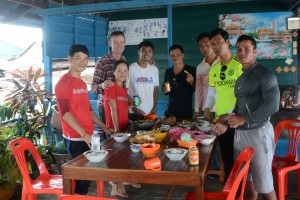 Left to right; Bunthy, Nick, Sreymom, Jin, Buntha, Poo, Ra & Lors
Left to right; Bunthy, Nick, Sreymom, Jin, Buntha, Poo, Ra & Lors
Pride swelled up in me, Khmers have a calm stoic strength though the flip side is that means they allow shit to happen before they do anything about it. Talking of which Heang’s boat broke down on the way back.
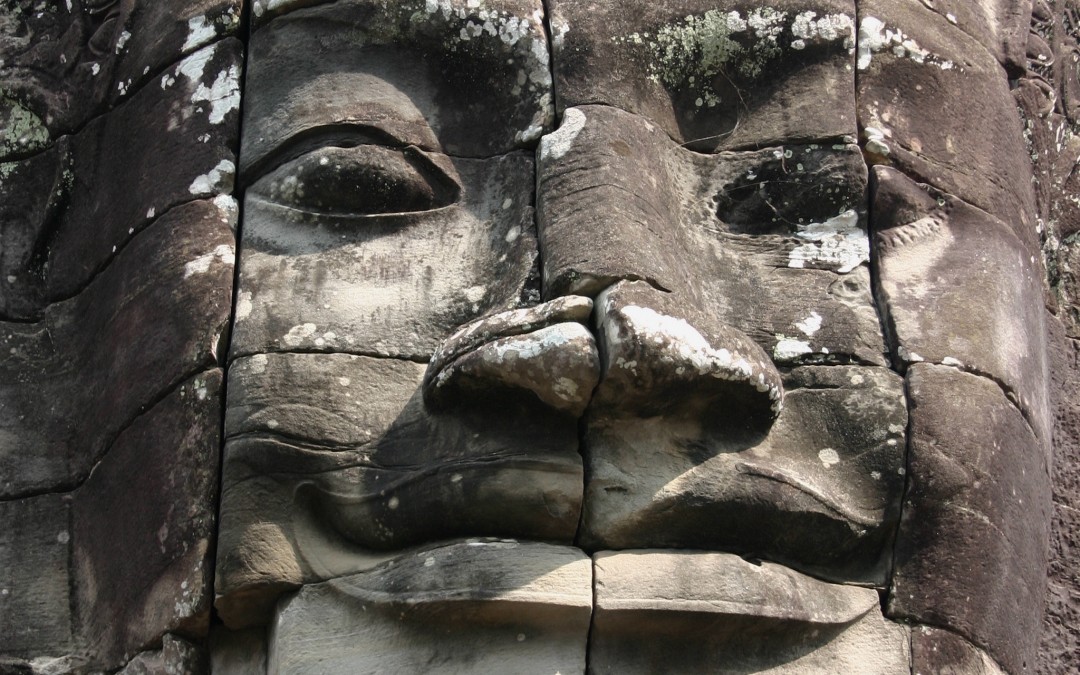
by Nick | Oct 25, 2017 | Angkor, Blog
JVII (Aka Jayavarman VII) with apologies to The Angkorian Empire
It gets confusing, 26 kings all ending in – varman, building thousands of temples and ruling for 500 years. So today’s story is going to concentrate on just one JVII with references to his uncle SII, who was by all accounts also a very great king. And to set the scene we need to mention JII, who started it all on a mountain (so he could throw stones on the Cham who continued to be revolting throughout the Angkorian era).
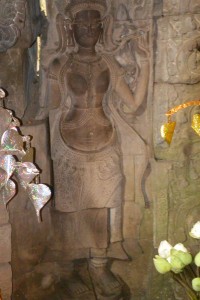 Thevi I
Thevi I
JVII was born early 12th century into an empire at the peak of its powers. The nephew of SII, who ruled over the Angkorian Empire when it covered most of South East Asia including Champa – home of the revolting Chams – ‘boo’ (now Central Vietnam). As a teenager JVII was sent to Champa to learn it’s ways including military techniques, which as you’ll see comes in useful later in the story. It’s said that a Khmer allied Cham royal family adopted him. His first wife who we’ll call Thevi I, and figures early in the story traveled with him to Champa.
Meanwhile back in Angkor SII, while at the height of his reign was murdered by one of his commanders, who declared himself King. Word reached JVII in Cham that his uncle had been assassinated so he set off with Thevi I to exact revenge on the Usurper but he was too late.
The revolting Cham sensing a weakening of The Empire launched a fleet of boats, sailed up the Mekong and into The Tonle Sap Great Lake to invade, sack and kill the Usurper. JVII realized he wasn’t ready to attack the Cham so he headed into the forest to assemble an army.
Oh and in the mean time got the temple bug and built his first, Preah Khan in Kampong Svay, not to be confused with its namesake in Angkor (more on that later).
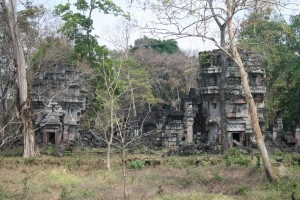 Preah Khan – Kampong Svei
Preah Khan – Kampong Svei
Time was ticking and JVII getting on so at the age of 53, which was as long as a lot of Khmers lived for at the time. He marched at the head of his army to defeat the Chams. This was where those early years in Champa came in successful and after a campaign of 4 years they were defeated and he proclaimed himself King of The Angkorian Empire. Guess what he did first? Build a temple of course. Preah Khan, which while not a particularly original name was generally regarded as a very good temple. So good in fact that he dedicated it to his Dad and moved in. JVII was also regarded as a very good king, the best in fact and one reason was his secular approach to religion. A Buddhist but not an exclusive one he included Hindu’s in government and encouraged them to use his temples (probably so he could spy on them).
The 4 year campaign had taken its toll on Thevi I worrying about her love fighting those revolting Cham, she died of a broken heart. Bereft of the younger sister JVII married the elder, who we’ll call Thevi II and with her support embarked on his first phase of construction. Mindful of Chams and Khmers who wanted their old Hindu religion back he needed an Angkorian broad band. In those days roads were the only way to control a rather large empire so he built a lot of them with rest houses every 15km.
 Back or South Gate of Preah Khan – Angkor
Back or South Gate of Preah Khan – Angkor
His brand of Buddhism was unusually kind for the time and espoused being nice to each other so he built 102 hospitals. Reservoirs, he loved building reservoirs and dams and channels to connect them. That’s a story in itself but as part of all this Mahayana Buddhist niceness, it meant that his people could grow a lot of rice with irrigated water from his channels. In this part of the world, where there’s rice there’s fish so he ensured Angkor’s food security. In turn the population, honed, toned and hunky with JVII’s obsessive temple building, were ready to take on revolting Chams.
Thevi II, you remember her? Actually it wasn’t so long ago that they had married – was a big cheese in The Empire, Director of The Buddhist University and responsible for the morality of the kingdom.
 Thevi II
Thevi II
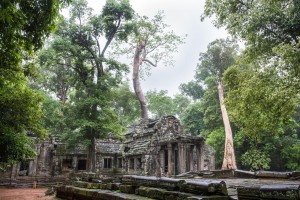 Ta Prohm
Ta Prohm
Flush with success from all this building for the people he got back to temples for himself and started his second phase of construction, commissioning Ta Prohm for his Mum. JVII must have dreamt of temples because he was churning them out. Culminating in the third phase of construction and his masterpiece the Bayon. It was modestly dedicated to him. Depicting Mt Mehru at the center of the Universe AKA Angkor Thom, the state temple while he was alive and his tomb when he died.
In the 13th century this was a city of 70,000 people living in a Florida style grid of villas each with their own pool and 2 Oxcart parking lots. Location, location, location JVII had the best, his wooden palace with of course a pool and for him elephant parking, looked out over The Bayon. The omnipresent loksvara, mugshots of himself carved into the stone pillars reminded those upity Hindu’s who was boss.
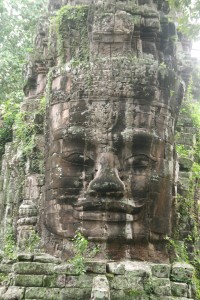 Loksvara said to be in the likeness of JVII
Loksvara said to be in the likeness of JVII
Old JVII, he was old by now probably around 70 when construction on Angkor Thom was started, had had a monumental life, certainly he left a lot of them. And must have wanted to record his achievements especially when if came to fond memories of bashing the Chams.
Unlike most Khmers today he didn’t have a smart phone so the next best thing was to commission an army of sculptures to carve out a comic relief on the walls of his state temple. Like the Terracotta Army in 2D great battle scenes are enacted, daily life depicted and the wonderful diversity of the Cambodian countryside recorded.

Above The Bayon and below a scene from the South East outer wall depicting the sacrifice of a water buffalo (another proof if need be of JVII’s regard for his people in that he stopped sacrificing them)
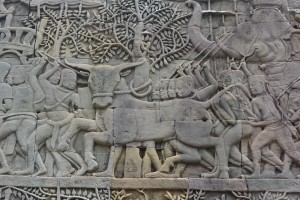
A great king not Mohammed, Jesus or Buddha himself but hey when you’ve reached your nineties and all your mates died 30 years ago perhaps not surprising JVII might have been thinking along those lines. These delusions of grandeur expressed in the construction of Angkor Thom a 9km square city, were beginning to sow the seeds for the subsequent decline of Angkor. The reservoirs and canals that had allowed hundreds of thousands of people to live in an infertile sand pit were not maintained and not prepared for the great drought and floods that followed his death. The system of water management was washed away and the city was no longer able to feed itself, but we’re getting ahead of our story. In the meantime his death; rumors abound, was it Hindu extremists, a jealous son, an estranged wife? At 95 years old it was probably old age.
The dates vary according to which account you read but all are remarkable for the time. 1125 seems to be a probable birth date and 1220 his death. He was crowned in 1181 at 56 and ruled for 39 years during which time Angkor became the greatest empire in the world, truly a great king.
Post script; JVII was succeeded by one of his surviving sons, we’ll call I (as in aye) 2, a leper who atoned for his sins by embellishing his Dad’s temples. JVIII is remembered as a religious vandal who spent most of his time knocking the heads off the Buddha’s that graced JVII’s temples.
by Nick | Apr 25, 2017 | Blog
Land of a Thousand Hills – or was it lakes
Drinking Tusker overlooking the valleys of Kigali City shrouded in wisps of dissipating cloud, the city appeared bottle green after flying across the brown plains of Africa.

The Virunga Volcanoes
The Embraer to Kigali was early but nobody was quite sure where to find it, not helped by the long way-lik lik arm wave of the dispatcher on the apron. There was an airplane next to Gate 21. The departures board showed Kigali Gate 22. There weren’t any other planes so I got on that one and watched a fellow passenger wander off across the tarmac.
A tall imposing customs official stopped me and pointed to my whisky. I took the bottle out of the bag and started to hand it to him, not happy he pointed to the bag. They must have a serious shortage of bags in Rwanda.
First impressions, there’s no litter, the penny dropped. Second I needed a glasses shop. The very nice African stewardess on Kenya Airlines and half the other passengers joined me in a hunt for my bizarrely disappearing glasses. In Kigali central Osman, my taxi driver found me an optometrist with a pair of disconcertingly red glasses.
That afternoon we went to look at snakes, ‘they’re all deadly’. We learnt about calamite or whatever it is that makes tin (actually the tin or sn ore is cassiterite). Oscar our guide, told me how the modern Rwanda came to pass, and why Kigali is where it is, which was something to do with the Germans. The Belgians took over until the country became independent in 1962. Tarzan was involved, I watched the film.
The land of a thousand hills or was it lakes, they go together, Kigali is hilly even mountainous, 1400 from the city center to where we walked at 1800 meters this afternoon.
Osman took great pride in pointing out how litter free the streets are. He’s right it’s a remarkably clean city, which made it seem strange when he threw his paper bag, sandwich wrapper and milk carton into the forest.

Muhbara Volcano @ 4100 meters Uganda
I had Nile perch for supper with tamarind or something that was sweet, spicy, delicious and expensive.
A man was lounging at the hotel reception counter. ‘You know me,’ he interrupted. I’d traveled all night, spent the day round the city and was not civil. ‘I don’t know you.’ I just wanted to go to bed. He pointed to his jacket, which had a small Volcano Safaris badge. ‘It would be a good idea if you introduced yourself,’ I said grumpily. ‘Come over here we will go through the itinerary,’ he told me. Also I wanted to shit. ‘Your picking me up at 8am I’ll see you then,’ and went to bed.

A weathered shrunken volcano with a sunken caldera near the Gahinga Lodge in Uganda
The wake up call for 7am came at 6 dragging me back from a sleep so deep I couldn’t remember where I was or what I was supposed to be doing. A sunny hazy day bathed the city below the breakfast verandah, buoying me with a positivity born of 8 hours solid sleep.
Today Robert looked different and professional. He lead me to the appropriately battered but immaculate Land Rover to take me to Uganda.
All smiles but why were we being pulled over. ‘Its clean up Saturday,’ explained Robert. On the last Saturday of the month the whole nation picks up litter, plants flowers and if all else fails carries a broom with them from 8 until 11am. Robert, who went up in my estimation (but later back down) managed to get us through without even a scrub. It would have been fun to join in but we were stopped 6 times and while contributing to Rwandan aesthetics is a worthy cause, gorillas were my mission.
It was an interesting drive through beautiful scenery though every last inch of the country appeared farmed, even the near vertical slopes were terraced. Fast running silt laden streams flowed down the lush valley floors. The trees are all eucalypt, introduced, planted and coppiced but there are no dogs and no hunting so a lot of birds. ‘Not like the Congo where they eat everything,’ said Robert. I thought of Cambodia.
The Congo, where there are still pygmies who hunt and gather in the vast un-gazetted forests and where volcanoes glow ominously in the night.
Rain greeted us in Uganda and veiled the countryside as we left the tarmac and climbed the dirt road to the lodge. Single story simple shacks with crude brick walls dull in the drizzle. Electricity poles compromised by an absence of wires promised electricity to come. High up the slopes of the Virunga Volcanoes but no where near the top was Gahinga Lodge. Umbrellas and wet welcomes, simple lodges, log fires and smiling Africans.
The food’s not good but the rest fantastic. I went for a walk. The view was primeval. That doesn’t make sense Man has shaped it but he hasn’t yet bulldozed the contours or filled in the lakes.
Rich volcanic soil supports cultivation up to the stonewall boundary of the national park. I saw the white markers from the track to the Irish potato Village (they’re all Irish). Cutting up the hillside along grassy strips between fields of potatoes as one would on dykes between paddy fields. I passed by simple houses surrounded by fences of woven vegetation to keep the chilly wind out.

My first site
The children shouted hello I assumed then ‘give me money’, which I understood. An amazing panorama spread below me. A weathered volcano with a sunken caldera that was completely cultivated.
And the town that we’d passed through on the way to Gahinga, where John friend of God had a guesthouse and over the border to the indented Rwandan lakes where and the next Lodge is.
On one side of the wall is an undulating sea of green ringing with the sound of birds that kept singing even when I got close. The Malachite Sunbird had a gown of emerald green but in case you’d missed him bright yellow flashes under his wings. An Auger Buzzard kept watch on a field below. I’d been given a glimpse of Eden over the wall. A forest fur covered extinct volcano 4100 meters high.
A guttural grunt at the back of his throat, warned us that we’d got too close. The female had a baby and Mac the silverback was looking after her.
The day hadn’t started well with the whisky I’d bought as insurance compounding the wine that came with the lodge. Yet another time change resulted in a mental mix up so 6 was 5 or the other way round.

Mac the silverback
The toast looked nice and there was honey but every time I tried to add butter it disintegrated into pieces like a paper napkin torn to shreds. The scrambled egg shot off the plate because the bacon was tough but at least the coffee was hot.
It started well enough until we got to the wild-west village down the hill. We’re not going back to Rwanda? I asked Robert. ‘No Muhbara in Uganda,’ ‘so I don’t need my passport?’ Half an hour later we were back where we started. I might have spent $600 on a park permit but I still had to prove who I was. ‘Not happy,’ I told Robert. A chill ensued.
A scramble along stone strewn alleyways between potato fields, past fences of drying vegetation that surround the local mud brick houses then we came to the park walls. The sign at the tracker station said 2400 meters. Robert bailed out, not that I’d noticed he was there, 2 trackers took over. A walky talky gabble and we were back outside the park walls traipsing over potato furrows.
A melodic hollow came from the forest and we were back over the wall crawling on our hands and knees between all things that pricked.
The prospect of spotting gorillas in these thickets seemed far fetched. A group of 3 trackers were waiting for us and pointed up to branches above that moved revealing a glimpse of black fur then a bit later a face with enormous nostrils and eyes framed by wrinkles. Well aware but not perturbed. We scratched and scraped our way round a dense patch of jungle to see different members of the 10 strong troop. Mac at 220 kg dominated the 2 other silverbacks but they were all enormous. 4 females, 2 youngsters and the 3 week old baby clinging to its mother.
Lemek, not a gorilla but part of the trekking team talked about their physiogamy. The trekkers recognized the different individuals, their characters, what they ate, where they nested and called the gorilla doctor when they were sick. ‘Doesn’t that compromise their ability to survive in the wild?’ I asked. ‘They increase but still so few they very important,’ answered Lemek. ‘What else, what other mammals live here?’ We’d seen civet, duiker and copious quantities of buffalo poo. ‘Elephants migrate between the parks around the Virunga Volcanoes in Uganda, Rwanda and the Congo but there are no big cats.’
For $600 you get an hour and time was running out. A fantastic experience but the best was saved till last. A juvenile made faces from up a bush, his face framed by the green fronds he ate. Mac came into the clearing and helped himself to a smorgasbord of vegetation until it all became too much effort and he lay down stretching and rolling in the sun.

The Batwa pretending to be wild
I got to know Be and Eddie at lunch and we got to know the Batwa that afternoon. The Batwa were nomadic forest pygmies moving around the volcanoes. An impossible life style for the 21st century but the nail in the coffin was the gazetting of the national park in 1992. They were evicted without land or recourse to make a living. The Batwa Experience was a couple explaining their former lives. The goat-skins were a little compromised by the tight black shorts with sequins that the lady was wearing.

We chewed leaves, shot arrows and lit a fire with a few sticks or they did. ‘If you had the chance would you go back to the forest?’ Yes.
The embers of the fire in my room still glowed, 2 hot water bottles warmed my bed and a stream sounded faint in the background. It was a very nice lodge.
I worked out how to butter the toast this morning. Put the butter on. Leave it till it gets soft then if careful you can spread without a toastal disintegration.

Mount Gahinga (3500 m) crater-lake
The gentle stroll up the road to the national park HQ gave a false sense of security. The 3500 meter volcano above was a slight hint of what was in store on my Gahinga Hike. Gruyere, that’s the closest to her name I could make out, explained to me everything that had been explained before apart from what we were going to do. She was very nice. Quite a big lady made bigger by her army fatigues. Felix joined us. Tall and tough with a large gun to protect me from buffalo G explained. Single males ostracized from the herd can get grumpy – tell me about it.

Other worldly plants & Felix (below)

Its green! This part of the world at least in the rainy season is green. An explosion of verdant vegetation populated by a lot of wild buffalo judging from the poo. About 20 minutes in G stopped to look at the view. There’s a lot of mountain left, I thought and pressed on.
Elderflower seemed strange, something to do with the British I expect, excepting which the flora appeared undisturbed and adapted to the increasing altitude. There were bark shredding trees near the HQ, bushes, bracken then great forests of bamboo.
Civet, serval, gennet and critically endangered golden monkeys dependent on the bamboo, sleeping up the stems holding on with their tails & prehensile fingers.
A duiker watched us for a while giving G the chance for a pause. Felix and I left her at a forest hut as the path tended towards the vertical. Slippery ladders took over from steps cut into the mud. The altitude diluted the intention and my legs became harder to work while my head hurt. Strange trees clad in beards of trailing lichen heralded the summit. The crater-lake covered in a floating carpet of virulent green made me wonder if we’d wandered onto another planet. It’s very deep and goes to the bottom of the mountain or so the legend goes. A pregnant lady was pushed in to punish her for adultery but because of God’s mercy she reappeared in another lake 2000 meters below. So now they don’t push in any more pregnant ladies.
G had nearly made it and offered pineapple for a pause, ‘we’ve had a pause,’ Felix and I kept going followed by G clutching her pineapple. A bushbuck aside we raced down the mountain chasing the prospect of a Nile Special (beer).
Eddy and Be worked for KLM. They are planning to open a lodge on the land they’d bought near Lake Victoria. Airlines like route directions are easy to talk about so we got on well.
Tonight’s beef tastes just like last night’s pork, it will be interesting to try the chicken.
Rwanda
Gorillas are what I came for not Australians, the happy clappy African guides tried to get us to introduce ourselves, it was like an NGO workshop.
At the Gahinga Park in Uganda by myself with the trackers finding the gorillas in the forest, was an experience, a discovery. Here on the Rwandan side in the Virunga National Park it felt like we were being processed. Our 2 guides were lovely as they told us now for the third time what we could and more particularly couldn’t do. After an age we set off through the potato fields to the edge of wilderness stopping every 200 meters to let the group catch up.
We might have been processed but the gorillas weren’t, their star quality transcended the touristy build up. Black shapes between bamboo poles. We circled round but with no clear sightings. A clearing later we found them having a break from replacing 15% of their body weight in edible vegetation every day. Pandas spring to mind but honestly gorillas have personality. The photos speak for themselves.

Gorilla’s with attitude
So much is being thrown back in my face on this trip in particular the interaction with those looking after me, both professionally and personally. It doesn’t justify the cost, it’s a holiday and the gorillas and the travel have ticked that box but it was useful. Helping me to understand how our customers must feel with some of the interactions we give them.






The Rwandan gorillas in The Virunga National Park
5 am it must be time to get up but no I had another half hour as the Golden Monkey bureaucracy is more efficient because the tourists come to see the gorillas and there’s not the $750 per person per hour involved.


A couple of the many species from my verandah
On the way to the tourist station at Muzanze, young men with corded arms wearing green and yellow waistcoats sat astride simple bicycles with a back seat. Why became clear when we got to the top of the hill 5km on.
They pick up passengers at the top of the hill free wheel to town then peddle back. Team Rwanda, a cycling cooperative, up and down that 1000m hill all day. Team UK wouldn’t have stood a chance if they’d entered the Olympics.
The mountain rose above us obscured by cloud, green fields sloped down from the park walls. We walked along potato furrows to grazing pasture and there in front of us were a troop of russet mantled Golden Monkeys.

A male Golden Monkey
A Glossy Ibis honked as it stabbed its bill into the soggy turf. Oliver our irrelevant guide pointed out the obvious monkeys plucking at the grass in front of us.
As with most things in this part of the world the females were more attractive than the males. Not exactly golden but russet compared to the grey boys. Golden Monkey society is a lot more liberal than Rwandan, as everyone seemed to be humping each other. We climbed over the wall into Eden and watched the monkeys using bamboo fronds to cross the swamps.

Female
‘You haven’t eaten your cheese cake!’ The chef confronted me. ‘It wasn’t a cheesecake, it was melted ice cream.’ He started explaining to me about his cheesecake so in case he didn’t get the message, ‘it wasn’t very nice.’ I’ve not seen him again.
The world catches up with a computer so I tackled the emails I’d ignored then went for a walk with Emmanuel. There’s Lake Burrera below my banda on the East side and Lake Ruhondo down on the West side. Burrera is a deeper and higher by a couple of hundred meters and used to flow across an isthmus of land over a waterfall into Ruhondo. Simple logic that this potential energy could be converted into power so a hydroelectric plant was built between them in 1952. It now supplies the electricity for Kigali.
Next fact is that the government is relocating 60 families from Bushongo Island in Lake Burrera to live on the slopes of the volcanoes, maybe the island can be left alone, without people.

Bushongo Island in Lake Burrera
Capture it in my memory banks and then replay as if it were there in front of me. I thought about what I’d seen while waiting for lunch in a corner of the balcony looking down to the islands in Lake Burrera.

SONY DSC
On a walk beside Lake Burrera with Emanuel
Emanuel gave me a more gentle and intelligent perspective of Rwanda than Robert’s aggressive party political broadcast such that I dared to ask the gay question. ‘We not say anything but we not respect. Its against God,’ said Emanuel.
Burrera came in and out of view as we walked beside green terraces of beans, sweet corn and cabbages. Every inch of land farmed or coppiced with eucalypt. Simple mud houses with corrugated roofs on red earth shelves cut out of the hillside. We reached the dam and made friends with the soldiers who told us we were welcome in a menacing sort of way.

by Nick | Mar 17, 2017 | Blog
An Angkorian Paddle
Background
The rise and fall of the Angkorian Empire, which lasted 500 years from the 9th to 14th century, was centered in what is now Siem Reap Province, around its greatest monument Angkor Wat. A population of a million in an area of 1000 km2 serviced the empire and built the religious structures the remnants of which we see today.

Angkor Wat Moat
Key to the success of the civilization was the management of water in a region of inundation and drought. An elaborate system of canals and barays or reservoirs channeled water from the Kulen Hills to the North into the city.
The availability of water ensured that food went in and shit went out. Canals facilitated the construction of the temples conveying the stone from the quarries to the North. And the temples were built with defensive moats that maintained ground water levels preventing their subsidence.

Runta Dev, the tunnel under the 8m high walls of Angkor Thom that channeled waste-water into the moat
It is now thought that the decline in management and maintenance of the hydrology coincided with that of the empire.
In recent years the importance of these systems has been recognized again as the massive increase in tourism has lead to ground water levels falling and the potential collapse of the temples. It is no coincidence that the best preserved are those with functioning moats.
One man has been championing the restoration of the Angkorian water management. He has overseen the construction of canals that channel the Siem Reap River into the North Baray, the moats of Preah Khan, Ankgor Thom and even Angkor Wat. Reducing the possibility of Siem Reap flooding as it did in 2011, while maintaining ground water levels.

Overseeing our progress up the North Baray Channel
These small matters aside obviously the most important function of Angkorian hydrology is to allow us to paddle through the Angkor Park, Cambodia’s best preserved 400 km2 of lowland mixed evergreen and deciduous forest.
And so it was one Monday morning that his excellency the Director of Water Management at Apsara, facilitated by Jady together with Buntha and myself kayaked through the heart of a Unesco declared world heritage site. Jady and I had previously recced Peou’s canal that diverts the flow from Siem Reap into the North Baray and round to the West Baray. This time we didn’t get lost and anyway Peou knew the way, but – we hadn’t followed the river as it heads South towards the Tonle Sap Lake.
The current had cut deep into the soft ground leaving 7meter high banks that we had to scramble down with our kayaks and then awkwardly get in them.
 Paddling down the Siem Reap River
Paddling down the Siem Reap River
A few fallen branches had accumulated enough flotsam and jetsam to block the river with no way through but a messy scramble. Jady and Buntha paved the way. Poeu and I made it easy.
There are 700 Angkorian structures inside the Angkor Park but only 180 of them can be called temples, they’re the ones with moats. These monumental stone edifices need solid ground for their structural integrity, without it they crumble to a pile of stones. Siem Reap is a built on a light sandy soil, water gives it substance, which is what the moats do for the temples.

Contemplating our adventure
A few hundred meters on either side there were no doubt bus loads of Asian tourists but here in the heart of Angkor we paddled passed explosions of bamboo erupting on either side. White-collared Kingfishers taunted Buntha to catch a photo. A Snake Eagle followed our progress from above, while a Shikra watched us with disinterest from a fallen branch. All manner of other birds sang from the trees on either side obliterating any thoughts of tourists or even other people.
We’d catered for 5 pax kayaking but one of the water management guys came along for the ride so the third kayak was one paddle power short and we had visions of Kosal, Jady’s assistant unable to move his shoulders for a month or 2. They’d had the sense to share the work and caught up beaming and claiming the big adventure.
Our driver had accumulated helpers by the time we reached the sluice gates at the French Bridge (confusingly built by Americans), who pulled us up the steep stairs to Jady’s vehicle.
It took a while to sink in that we had paddled through one of the wonders of the world, visited by 3 million people but seen none, instead thick riparian forest as if we were discovering it for the first time.

 Areykhsat on the East Bank of The Mekong
Areykhsat on the East Bank of The Mekong Phnom Penh on the West bank of The Mekong
Phnom Penh on the West bank of The Mekong Setting up the games with our Team the day before
Setting up the games with our Team the day before Mobileiron Braves on the warpath
Mobileiron Braves on the warpath Wobileirons climbing the sugar palm pole
Wobileirons climbing the sugar palm pole

 The Anglo Saxons reaching the foregone conclusion that they’d won
The Anglo Saxons reaching the foregone conclusion that they’d won
 Spectators @ The Tug of War (below)
Spectators @ The Tug of War (below)





 Setting off at Prasat Prahoc, from left to right; Buntha, Ra, Jin, Lors and Nick
Setting off at Prasat Prahoc, from left to right; Buntha, Ra, Jin, Lors and Nick
 The Upper Sangke flowing through rural Battambong Province
The Upper Sangke flowing through rural Battambong Province
 Adventure bars and coffee as we entered the middle Sangke, where stilted houses give way to floating villages.
Adventure bars and coffee as we entered the middle Sangke, where stilted houses give way to floating villages. Weaver Bird nests
Weaver Bird nests Into the Tonle Sap Floodplain
Into the Tonle Sap Floodplain The encroaching lake
The encroaching lake The shortcut, an enchanted alley cut through the seasonally flooded forest
The shortcut, an enchanted alley cut through the seasonally flooded forest
 Heang towing us out of a hyacinth jam
Heang towing us out of a hyacinth jam Phum Bakprea, picking up bananas
Phum Bakprea, picking up bananas Chased by a storm down the river
Chased by a storm down the river Lors and the boys cooking dinner.
Lors and the boys cooking dinner. Setting off a little less enthusiastically on our second morning
Setting off a little less enthusiastically on our second morning Heavy hanging grey clouds at least meant we weren’t being grilled by the sun.
Heavy hanging grey clouds at least meant we weren’t being grilled by the sun.
 Lors and Jin towards the end
Lors and Jin towards the end Lors, Heang, Nick, Ra and Jin at the end.
Lors, Heang, Nick, Ra and Jin at the end.
 The Team setting up the kayaks (left), Buntha & Lors (below)
The Team setting up the kayaks (left), Buntha & Lors (below)
 Moving house as The Lake fills
Moving house as The Lake fills The Team in the open channel
The Team in the open channel Lors and Jin heading into the hyacinth
Lors and Jin heading into the hyacinth Stuck!
Stuck! Hijacking the illegal fisherman’s long-tail
Hijacking the illegal fisherman’s long-tail Left to right; Bunthy, Nick, Sreymom, Jin, Buntha, Poo, Ra & Lors
Left to right; Bunthy, Nick, Sreymom, Jin, Buntha, Poo, Ra & Lors
 Thevi I
Thevi I Preah Khan – Kampong Svei
Preah Khan – Kampong Svei  Back or South Gate of Preah Khan – Angkor
Back or South Gate of Preah Khan – Angkor Thevi II
Thevi II Ta Prohm
Ta Prohm  Loksvara said to be in the likeness of JVII
Loksvara said to be in the likeness of JVII




























 Paddling down the Siem Reap River
Paddling down the Siem Reap River 